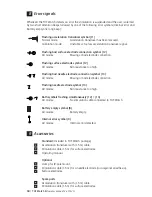
4.2.3
Post Tetanic Count stimulation (PTC)
press
(2)
Starts Post Tetanic Count
(if allowed).
PTC starts with stimulations at a frequency of 1 Hz for 15 s. PTC is visible in
the display. When no responses are detected (i.e. when the neuromuscular block is
deep), this is followed by a 5 s 50 Hz stimulation. After a 3 s pause, stimulations
are performed at a frequency of 1 Hz for 15 s, while the number of detected
responses (Post Tetanic Count, updated after each stimulation) is shown in the
display. A short information beep indicates that the PTC is finished
The number of detected responses is shown on the display for 12 s after which
the TOF-Watch automatically enters the continuous TOF stimulation mode.
■
■
Post Tetanic Count can only be used when the responses to 1 Hz, 0.1 Hz or TOF
have disappeared (when the patient is deeply relaxed).
■
■
If the patient responds (more than five consecutive responses) during the first 15
stimulations, the TOF-Watch automatically switches to TOF-mode after 5 s.
■
■
The TOF-Watch automatically prevents the use of the PTC button for 2 minutes after
successful operation of PTC. If activated before the time-out period has expired an
information beep will sound, PTC will be shown flashing for 5 s, if no other test is
running, and the TOF-Watch automatically reverts to its original mode.
4.3
Secondary functions
Secondary functions can be activated by pressing the secondary function button (4) prior to a
stimulation button. If no stimulation buttons are activated within 5 s after pressing the
secondary function button, the TOF-Watch automatically reverts to primary mode. When the
secondary function button (4) is activated, the
■
symbol will be shown on the display.
4.3.1
TOF s stimulation
first press
(4),
then (3)
Starts repetitive TOF s stimulation.
TOF s stimulation is TOF stimulation with user programmable repetition time
between 1 and 60 minutes. To be used in the I.C.U. or during surgery of long
duration. The repetition time can be programmed in the set-up menu (see
Set-up
menu
, page 15).
Hz
%
13
|
TOF-Watch S
Operator manual 33.516/A







































